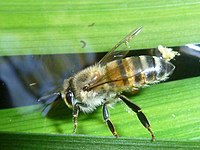
Photo from wikipedia
Abstract Background Honeybee colonies differ in performance due to variations in their traits in terms of production, productivity and behaviour. The objective of this study was to identify and evaluate… Click to show full abstract
Abstract Background Honeybee colonies differ in performance due to variations in their traits in terms of production, productivity and behaviour. The objective of this study was to identify and evaluate the performance of honey bee race at their geographical location. Methods A total of 20 honey bee colonies from traditional hives were transferred into frame hives and arranged randomly with enough space between the colonies. Colonies were evaluated for aggressiveness, hygienic behaviour, brood area, pollen and nectar stores, absconding and honey yield. Results The results indicated that colonies were generally aggressive, and the majority of colonies at 2.3‐m away from the entrance reacted to the external body. They removed 95.7% ± 0.75% of the pin‐killed pupae in 24 h, and there was significant (p < 0.05) variation among the different observations. The average population of the brood was 24.925 ± 7.714 unit area of brood/hive during the honey flow period. Similarly, the area allocated for storing pollen grains could reach up to 11.46 ± 3.96‐unit area of pollen/hive. The swarming and absconding behaviour of the race was on average 3.39 ± 0.6, and 25% queen cells were found during the breeding season and dearth period, respectively. On average, the 8.85 ± 0.54 kg honey yield per colony per harvest on one honey chamber box was nearly similar to the national average (19.4 kg/hive/year) when harvested two times per year. Conclusion In general, the Apis mellifera secutellata race is good in hygienic tendency and also performs well for honey yield under optimal management practices. The absconding and aggressive behaviour was high; the main reasons were extreme weather condition, and different pest and disease, seasonality of bee flora were the major ones. So, based on the current findings A. m. scutellata was predominantly available in the area and highly productive if well‐managed. On the other hand, we are recommended on dearth period management and on the height of shade bee colonies.
Journal Title: Veterinary Medicine and Science
Year Published: 2022
Link to full text (if available)
Share on Social Media: Sign Up to like & get
recommendations!